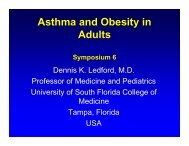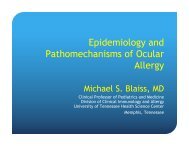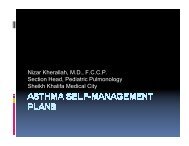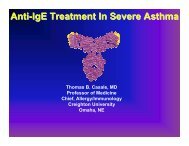Dubai Final-v20.indd - World Allergy Organization
Dubai Final-v20.indd - World Allergy Organization
Dubai Final-v20.indd - World Allergy Organization
You also want an ePaper? Increase the reach of your titles
YUMPU automatically turns print PDFs into web optimized ePapers that Google loves.
ABstrACts<br />
ABstrACts<br />
uptake, dominated the disease with medium-severe course. Conclusion: Epidemiological studies can provide reliable information<br />
on the prevalence, structure and severity of AD. monitoring of the true prevalence of AD shows hypodiagnostics of all forms of AD in<br />
the Cis-C, related to the underestimation of mild forms of the disease. Accounting for the structure and expression of sensitization<br />
to allergens, taking into account climate and geographic features, allows to plan the work of allergic services and to organize<br />
preventive and curative interventions.<br />
1312<br />
gUiDElinES aPPliCaTion For aSTHma anD rHiniTiS managEmEnT: arga (rESPiraTorY allErgiC DiSEaSES:<br />
moniToring STUDY oF gina anD aria gUiDElinES) ProJECT<br />
Baldacci, s. 1 , maio, s. 1 , Cerrai, s. 1 , sarno, g. 1 , Borbotti, m. 1 , Angino, A. 1 , martini, F. 1 , Carrozzi, l. 1 , Di Pede, F. 1 and Viegi, g. 2<br />
1 2 institute of Clinical Physiology, national research Council, Pisa, italy. Cnr institute of Biomedicine and molecular immunology,<br />
Palermo, italy.<br />
Background: in italy, a big effort has been made to disseminate ginA and AriA guidelines (gl) for asthma and rhinitis management<br />
within the setting of specialist and general practice. Despite a general good knowledge of gl, their implementation within the<br />
clinical practice seems still poor.<br />
Objective: to assess the level of application of gl for asthma and rhinitis management within general practitioners (gP).<br />
methods: cross-sectional italian survey (2007-10); 107 gP (89% of the expected sample) enrolled patients with asthma/rhinitis<br />
diagnosis and pharmacologic treatment and/or rhinitis/asthma symptoms in the last 12 months.<br />
For each patient (n=1820), a questionnaire was filled in by gPs on: diagnosis of allergopathies, asthma and rhinitis severity<br />
according to gl, instrumental tests used for diagnosis/monitoring, educational activity, drug prescriptions for asthma/rhinitis.<br />
results: patients are: 47% rhinitic (7% moderate-severe persistent), 25% asthmatics (2% severe persistent) 28% with both asthma<br />
and rhinitis (Ar) (8% with moderate-severe persistent rhinitis, 6% with severe persistent asthma).<br />
the prevalence of prescribed instrumental tests for rhinitis diagnosis/monitoring ranges between 32% (objective nasal test) and<br />
62% (prick test) while for asthma is between 6% (exhaled nitric oxide) and 87% (spirometry). Ar increases the prevalence of<br />
prescribed instrumental tests for rhinitis and decreases that for asthma instrumental investigations.<br />
58% of rhinitic patients, 68% of asthmatics and 68% of Ar subjects receive a specific education (regular controls, written<br />
therapeutic plans, auto-monitoring education, support groups). 35% of rhinitic, 29% of asthmatics and 26% of Ar patients receive<br />
general information. 6% of rhinitic, 3% of asthmatics and 5% of Ar patients do not receive any educational intervention.<br />
Considering the prescribed pharmaco-therapeutic categories, 43% of rhinitic, 77% of asthmatic and 54% of Ar subjects do not<br />
receive an appropriate treatment in relation to the severity level.<br />
Conclusions: contrary to gl recommendations, use of instrumental tests for asthma and rhinitis diagnosis/monitoring appears still<br />
incomplete as well as use of specific educational support for the patients. Anyway, it is the pharmacologic treatment for rhinitis and<br />
even more for asthma that presents the lower level of implementation within the general practice.<br />
Work supported by the italian medicines Agency (AiFA), contract no. FArm5JYs5A.<br />
1313<br />
inHalED SoDiUm CromoglYCaTE rEDUCES THE EXPrESSion oF aSTHma-rElEVanT CYToKinES BY PEriPHEral BlooD T<br />
CEll in CHilD aSTHma. THiS SUPPorTS iTS PoSSiBlE USE aS PrEVEnTaTiVE THEraPY in CHilD aSTHma<br />
gemou-Engesaeth, V. 1 , Hamid, Q. 2 , roedland, E. A. 3 , Heier, H. E. 4 , gaarder, P. i. 4 , grogaard, J. B. 1 , Halvorsen, s. 1 and Corrigan, C. J. 5<br />
11Dept. of Pediatrics, Oslo Univers. Hospital5King’s College london school of medicine and 6Athens University, A Pediatric Clinic,<br />
Oslo, norway. 2mcgill University, meakins-Christie laboratories, montreal, QC, Canada. 33institute of medical microbiology,<br />
rikshospitalet, molecular Biology, Oslo, norway. 4Dept. of immunology and transfussion medicine, Oslo University Hospital, Oslo,<br />
norway. 5Centre for Allergic mechanisms of Asthma, King’s College london school of medicine and mrC and Asthma, Centre for<br />
Allergic mechanisms of Asthma, london, United Kingdom.<br />
We addressed the in vivo anti-inflammatory effects of inhaled sodium cromoglycate (sCg) in childhood asthma. Ethical approval<br />
was granted by the regional ethics committee. All patients and their parents received written information concerning the purpose of<br />
the study, and parents provided written consent.<br />
seven asthmatic children aged 7-13 years needing regular preventative therapy for the first time for asthma control were followed<br />
for 4-6 (mean 4.8) months after commencing sCg at a dosage of 10 mg 4 times daily by metered-dose inhaler. Just prior to<br />
commencing therapy and at the end of follow-up, CD4 and CD8 t cells were isolated from peripheral blood samples and the<br />
percentages of these cells expressing mrnA encoding interleukin-4 (il-4) and il-5 determined using in situ hybridisation with<br />
specific, anti-sense riboprobes. Clinical improvement was accompanied by significant reductions in the percentages of peripheral<br />
www.worldallergy.org 104<br />
FinAl PrOgrAm

















